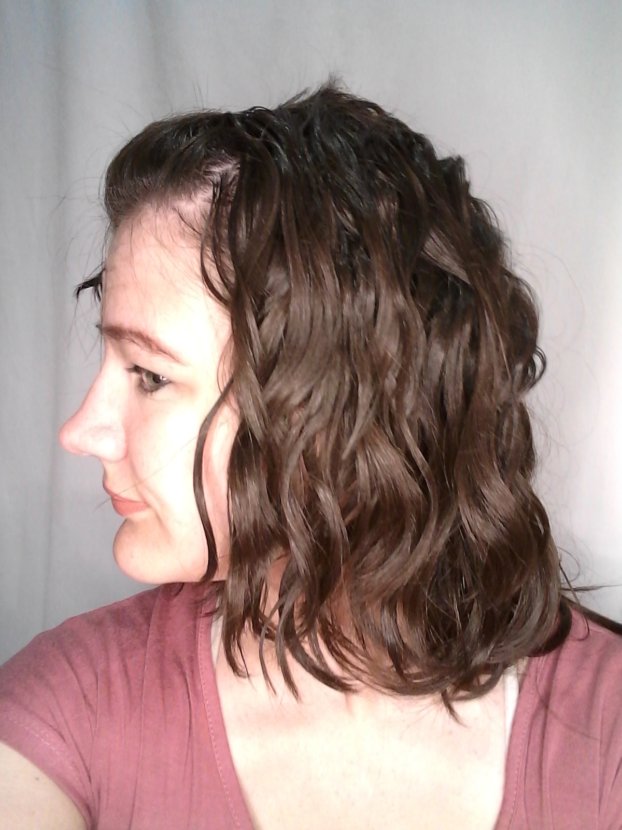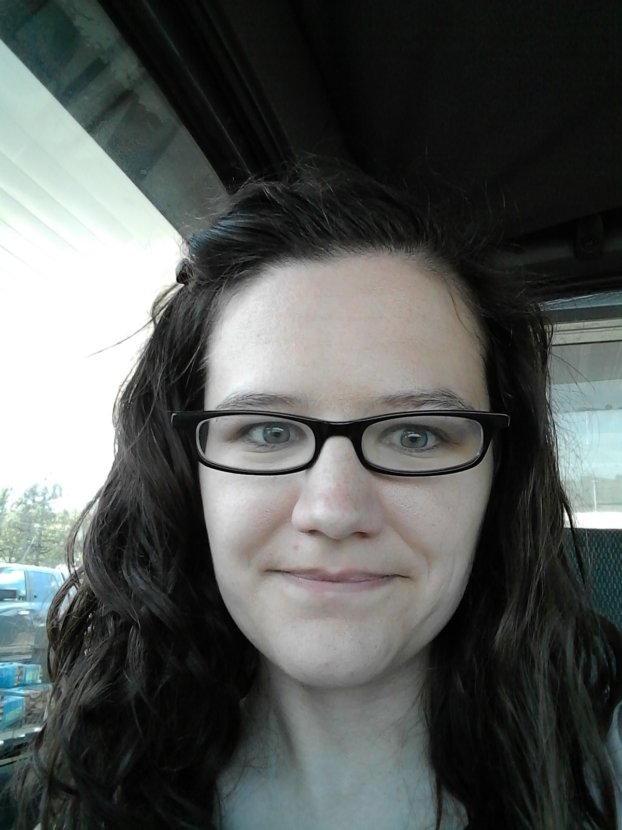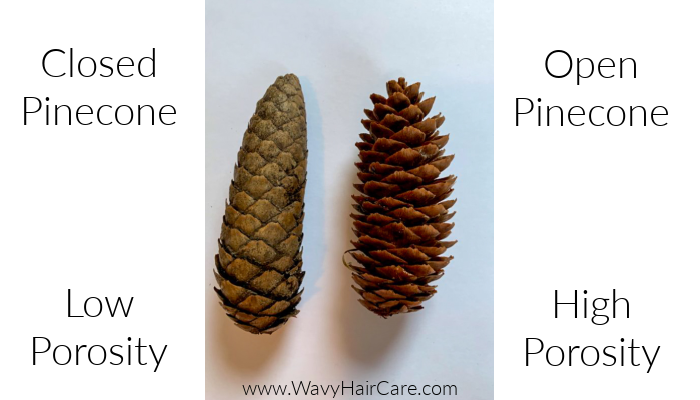There are affiliate links in this post.
What Is Low Porosity Hair?
Low porosity hair is hair that has tightly closed hair cuticles. Our hair cuticle is often compared to a pinecone (closed for low porosity, open for high porosity). Another analogy for the hair cuticle is a shingled roof, with a newly made roof being low porosity, and a roof with some raised/curling shingles and/or missing shingles being high porosity.
Having a tight, closed cuticle means that once water gets into your hair strand, it’s likely to stay nice and hydrated as the tight cuticle will be great at holding water in your hair. It may be harder for water and hair product ingredients to get into your hair though. For this reason, some with low porosity hair struggle with dry hair while others with low porosity hair struggle with over-moisturized hair.
If you have low porosity hair and aren’t successful at getting water and products into your hair strands, it can become dry. If you have low porosity hair and are successful at getting water and products into your hair strands, it can become over-moisturized.

Signs That You Have Low Porosity Hair
Your hair is shiny. Shiny hair is just hair that is good at reflecting light. Flat, smooth surfaces reflect light better than rough/bumpy surfaces. Low porosity hair has a smooth, closed cuticle so it’s often good at reflecting light. High porosity hair has a raised and bumpy cuticle so it won’t reflect light as well or look shiny. Some hair product ingredients like silicones and oils can “artificially” cause shine in your hair, too though.
Smooth hair strands. Low porosity hair has a tight, closed cuticle that will make the surface the hair feel smooth, maybe even silky-soft. This can also be impacted by hair strand thickness somewhat. Low porosity thick or coarse hair may feel rougher than fine low porosity hair. Hair product ingredients can also impact how smooth hair feels, so consider this one when your hair is product-free.
Slow to dry. Once water gets into the center of low porosity hair, the cuticle holds the water in really well! This results in hair taking a long time to dry…especially if you also have dense hair.
Rarely tangles. Having a smooth hair cuticles mean your individual hairs aren’t likely to catch on each other which means fewer tangles. However, low porosity hair that is just dry and not well conditioned may tangle due to a lack of elasticity or softness.
If all of these sound a little wishy-washy…that’s because they are! To determine your hair porosity you really have to look at a lot of factors. There is no one sign that can tell you for sure if your hair is high or low porosity.
Challenges Of Low Porosity Hair
Hard to get hair products to penetrate. We want most hair products to get into our hair strands, rather than just sit on our hair. With low porosity hair, products are more likely to sit on top, especially if they have oils or butters or ingredients that have larger molecules.
Will get buildup easier due to products not sinking into hair as well.
Easily weighed down. This is largely caused by products sitting on hair rather than sinking in.
Hair takes longer to dry, especially if you also have dense hair.
Prone to getting over-moisturized due to water staying in hair longer.

What To Avoid With Low Porosity Hair
Heavy hair products (oil-free products may work best for you).
Leave-in conditioner or creams (maybe). If you struggle with dryness, leave-in conditioners or creams can be helpful. For people with low porosity hair who have a good handle on keeping their hair moisturized, they may not need leave-in conditioners or creams at all.
Consistently using super hydrating routines such as the bowl method. Regularly using methods like this are likely to result in over-moisturized hair for people with low porosity hair. However, occasional use may be beneficial for low porosity hair to get rehydrated.
How To Care For Low Porosity Hair
Don’t neglect protein. It’s commonly shared that high porosity hair needs more protein than low porosity hair. This is true, but that doesn’t mean that low porosity hair shouldn’t have protein at all. All hair benefits from some protein. If you struggle with dryness, try using hydrolyzed proteins as they are small and easier to get into your hair strands.
Squish to condish to aid with hydrating if you’re struggling with dryness or with getting hair products into your hair strands.
Use a diluted leave-in conditioner that is lightweight if your hair is dry. Not all low porosity hair will need a leave-in, but if you do, try mixing it with water. You can do this by adding water to your hands after spreading your leave-in conditioner in your palms, or you can apply your leave-in conditioner and then dip your head under your showerhead briefly to re-wet it and let some of the conditioner back out. Lightweight is really key!
Use film-forming humectants to hydrate (Source: science-y hair blog).
Pre-poo. If feeling dry or lacking elasticity, try a pre-poo to add softness and flexibility.
Clarify (and/or chelate) regularly to get rid of build-up. I occasionally come across posts in wavy & curly hair groups that say things like “I have EXTREMELY low porosity hair. Even products that everyone says are light and don’t cause buildup feel waxy in my hair! What can I do?”. People with experiences like that may have low porosity hair as well, but if you feel like your hair won’t tolerate any products you likely have buildup that is clogging your hair and keeping products out. If you have hard water use a chelating shampoo rather than just a clarifying shampoo. I have a blog post on clarifying wavy hair and signs that you need to clarify.
Diffuse so your hair doesn’t stay wet for hours. This isn’t just for convenience, but also for your hair health. It can cause damage to your hair if it regularly stays wet for really long periods of time. I have a blog post sharing four tutorials for how to diffuse wavy hair.
Does Low Porosity Hair Need Protein?
All hair needs some protein, including low porosity hair. Low porosity hair does need less than high porosity hair, but other hair factors impact protein needs as well. Fine hair needs more protein than coarse hair, for example.
My own hair is low porosity but my hair stands are fine so I typically focus more on protein than moisture in my routines.

Does The Float Test Teach You Your Hair Porosity?
A test where people are told to put a hair strand in a glass or bowl of water and see if it siks after a couple of minutes is commonly shared as a way of determining your hair porosity. People say if your hair sinks quickly that shows that you have high porosity hair because the water got into your hair strand quickly, causing it to gain weight and sink. Alternatively, if your hair continues to float for a few minutes or more, this is said to be a sign of low porosity hair because the water isn’t getting into the hair strand and letting it sink.
While this float test is really commonly shared in wavy and curly hair groups, it is not a very accurate test. If your hair floats or not could somewhat be impacted by porosity, but it can also be impacted by MANY other factors.
To give you a few examples – fine hair may float longer than coarser hair due to the weight differences caused by hair thickness. Hair may continue to float if it gets caught in the water surface tension (did anyone else do the science experiment of getting a paperclip to float as a kid?). Even if using a freshly shampooed hair strand, you may still have product remanents on the hair which may block out water, and keep it afloat.
For these reasons and others, I don’t recommend trusting the float test by itself. I recommend that you determine your hair porosity using multiple factors rather than any one test. I have a blog post sharing my advice for how to determine your wavy hair type that includes porosity.
Product recommendations for low porosity wavy hair
GVP conditioning balm (from SallyBeauty.com) [For dry low porosity hair]
Giovanni Direct Leave-in (Walmart – or iHerb, Walgreens)
As I Am Naturally Leave-In Conditioner ( SallyBeauty / Walmart)
Suave Daily Clarifying Conditioner (Walmart) [For occasional clarifying washes, not daily use.]
Johnsons kids curl defining shampoo (Walmart / Amazon.com)
Johnson’s kids strengthening conditioner (Walmart / Amazon)
Pacifica pineapple curls shampoo & conditioner (Amazon)
Not Your Mother’s Rice Water and Himalayan Moringa shampoo & conditioner (Ulta, Target)

I don’t have wavy hair (I wish!). But I have a friend who can’t spend the time or the money on herself that it will take to treat her beautiful wavy hair! I recently was given a gift card for some public service I did and I’m passing along the favor and suprising her with a haircare set. This blog really helped me to find out a little bit more about what I’ll need to get for her. Thank you!
That’s so kind of you! I’m glad you found it helpful. 🙂